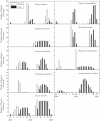Diversity of flowering and fruiting phenology of trees in a tropical deciduous forest in India
- PMID: 16357055
- PMCID: PMC2803360
- DOI: 10.1093/aob/mcj028
Diversity of flowering and fruiting phenology of trees in a tropical deciduous forest in India
Abstract
Background and aims: In the dry tropics, vegetative phenology varies widely with tree characteristics and soil conditions. The present work aims to document the phenological diversity of flowering and fruiting with reference to leafing events in Indian dry-tropical tree species.
Methods: Nine tree species, including one leaf-exchanging and eight deciduous showing varying leafless periods, were studied. Monthly counts of leaves, flowers and fruits were made on 160 tagged twigs on ten individuals of each species for initiation, completion and duration of different phenological events through two annual cycles.
Key results: Variation in flowering relative to leaf flushing (which occurred just prior to or during a hot, dry summer) revealed five flowering types: summer flowering (on foliated shoots), rainy-season flowering (on foliated shoots following significant rains), autumn flowering (on shoots with mature leaves), winter flowering (on shoots undergoing leaf fall) and dry-season flowering (on leafless shoots). Duration of the fruiting phenophase was shortest (3-4 months) in dry-season and winter-flowering species, 6-9 months in rainy-and autumn-flowering species, and maximum (11 months) in summer-flowering species. A wide range of time lag (<1 to >8 months) between the start of vegetative (first-leaf flush) and reproductive (first-visible flower) phases was recorded in deciduous species; this time lag was correlated with the extent of the leafless period. A synthesis of available phenological information on 119 Indian tropical trees showed that summer-flowering species were most abundant (56 % of total species) amongst the five types recognized.
Conclusions: The wide diversity of seasonal flowering and fruiting with linkages to leaf flush time and leafless period reflect the fact that variable reproductive and survival strategies evolved in tree species under a monsoonic bioclimate. Flowering periodicity has evolved as an adaptation to an annual leafless period and the time required for the fruit to develop. The direct relationship between leafless period (inverse of growing period) and time lag between onset of vegetative and reproductive phases reflects the partitioning of resource use for supporting these phases. Predominance of summer flowering coupled with summer leaf flushing seems to be a unique adaptation in trees to survive under a strongly seasonal tropical climate.
Figures




References
-
- Ashman TL, Schoen DJ. 1997. The cost of floral longevity in Clarkia tembloriensis: an experimental investigation. Evolutionary Ecology 11: 289–300.
-
- Borchert R. 1996. Phenology and flowering periodicity of neotropical dry forest species: evidence from herbarium collections. Journal of Tropical Ecology 12: 65–80.
-
- Borchert R. 2000. Organismic and environmental controls of bud growth in tropical trees. In: Viemont JD, Crabbe J, eds. Dormancy in plants: from whole plant behavior to cellular control. Wallingford: CAB International, 87–107.
-
- Borchert R, Rivera G, Hagnauer W. 2002. Modification of vegetative phenology in a tropical semi-deciduous forest by abnormal drought and rain. Biotropica 34: 27–39.
-
- Borchert R, Meyer SA, Felger RS, Porter-Bolland L. 2004. Environmental control of flowering periodicity in Costa Rican and Mexican tropical dry forests. Global Ecology and Biogeography 13: 409–425.

